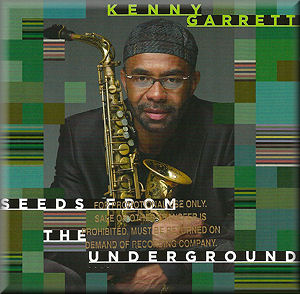1. Boogety Boogety
2. J. Mac
3. Wiggins
4. Haynes Here
5. Detroit
6. Seeds From The Underground
7. Du-Wo-Mo
8. Welcome Earth Song
9. Ballad Jarrett
10. Laviso, I Bon?
Kenny Garrett - Alto sax, soprano sax, piano
Benito Gonzalez - Piano
Nat Reeves - Bass
Ronald Bruner - Drums
Rudy Bird - Bata, percussion
Nedelka Prescod - Vocals
One of the reviews I read of this album described Kenny Garrett as a "post-Coltrane improviser". This is what sets him apart from many other alto-saxists: he seems to have transferred John Coltrane's tenor-sax sound to the alto. This has good and bad effects. It means that he uses a wide-open improvising method assisted by a superb technique, although it also means that he sometimes ascends into the sort of screeching and screaming that make some of Coltrane's recordings almost unbearable.
This new CD is what we might call a "concept album", as Kenny claims that every track pays homage "to those who have inspired and influenced him, both personally and musically". So J. Mac salutes Jackie McLean; Wiggins refers to his high-school band director Bill Wiggins; Detroit is a tribute to trumpeter and mentor Marcus Belgrave as well as to Kenny's home city; and Du-Wo-Mo refers to Duke Ellington, in whose orchestra Garrett played when he was only 18 (although the orchestra was by then led by Mercer Ellington), as well as Woody Shaw and Thelonious Monk. Some of the dedicatees are obvious (like Roy Haynes, recognised in Haynes Here) but others are more obscure.
The press pack quotes Garrett as saying "I wanted to focus on the melody. I want people to remember what the melody is before we start improvising". Kenny's repertoire, all written by him, includes some accesible melodies and is certainly more melodic that that of some other modern jazzers. Yet one can't help noticing that many of the melodies are based on shifting riffs which can become repetitive. This tendency is mitigated by the stimulation of Rudy Bird's Latin percussion and some experiments with time signatures (for example, Wiggins seems to be in seven-four).
The sound palette is varied by the wordless vocals of Nedelka Prescod. Detroit and Welcome Earth Song have a wordless choir (only credited on the latter track), which adds a gospel feel. And Benito Gonzalez' Tyneresque piano adds to the rhythmic power of every track as well as contributing impressively dextrous solos.
But the main focus is on Kenny Garrett and his alto and soprano saxes. He can vary the pitch of the alto sax so that it sounds as low as a tenor or as high as a soprano. He is undoubtedly a powerful player who seems to demand attention: able to build almost every song to a potent climax which makes you sit up and listen, although he is less musical when he starts to screech like a stuck pig. He is perhaps most effective in Ballad Jarrett, a slow number which is the most lyrical and moving track on the album, without any excesses.
I wonder why it was thought necessary to add the crackles of an old 78 r.p.m. record to Detroit.
Tony Augarde
